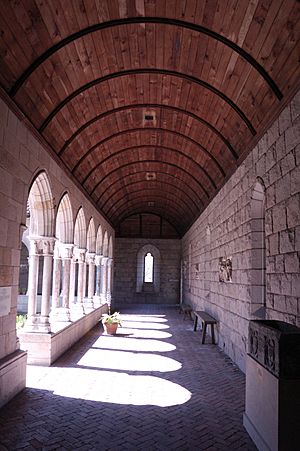Barrel vault facts for kids
A barrel vault, also known as a tunnel vault or a wagon vault, is a special type of ceiling that looks like a long, continuous arch. Imagine cutting a tunnel in half lengthwise – that's the shape of a barrel vault! It's an important part of architecture and has been used for thousands of years to create strong and beautiful roofs over buildings.
Contents
What is a Barrel Vault?
A barrel vault is basically an arch that has been stretched out to form a long, curved roof. Think of a half-cylinder shape. This design is very strong because it pushes the weight of the roof downwards and outwards along its entire length. This outward push, called "thrust," needs to be supported by strong side walls or other structures.
How They Are Built
To build a barrel vault, workers would first create a temporary wooden frame in the shape of the desired arch. Then, they would lay bricks or stones over this frame. Once the mortar (the "glue" holding the bricks together) was dry and strong, the wooden frame could be removed. The vault would then stand on its own, creating a sturdy and often grand space below.
Why Use Barrel Vaults?
Barrel vaults were popular for several reasons:
- Strength: They are very strong and can support heavy roofs, making them great for large buildings.
- Fire Resistance: Unlike wooden roofs, stone vaults were much less likely to catch fire, which was important for churches and important buildings.
- Large Spaces: They allowed builders to create wide, open spaces without needing many columns in the middle.
History of Barrel Vaults
Barrel vaults have a long and fascinating history, dating back thousands of years.
Ancient Times
The earliest known barrel vaults were built in ancient Egypt and Mesopotamia. However, the Ancient Romans were masters of this technique. They used barrel vaults extensively in their buildings, such as:
- Baths: Public bathhouses often had large, vaulted rooms.
- Basilicas: These were large public halls used for law courts and meetings.
- Aqueducts: Some parts of these water channels were covered with vaults.
- Temples: Many Roman temples featured impressive barrel-vaulted ceilings.
The Romans often used concrete to build their vaults, which made them even stronger and easier to construct.
Medieval Period
After the fall of the Roman Empire, barrel vaults continued to be used in Europe. They were a key feature of Romanesque architecture, which was popular from about the 10th to the 12th centuries. Many grand cathedrals and churches from this period feature long, barrel-vaulted naves (the main part of the church). These vaults often made the interiors feel very tall and majestic.
Modern Uses
While not as common in new buildings today, barrel vaults can still be found in many historic structures around the world. You might see them in:
- Old train stations
- Museums
- Underground tunnels
- Even some modern buildings that want to capture a classic look.
Images for kids
-
Coffered ceiling of the barrel-vaulted nave in the Temple of Jupiter at Diocletian's Palace in Split, Croatia. Built early 4th century.
-
Nave of Lisbon Cathedral with a barrel vaulted soffit. Note the absence of clerestory windows, all of the light being provided by the Rose window at one end of the vault.
-
Barrel vault in a mausoleum at the Recoleta Cemetery, Buenos Aires, Argentina
-
Barrel vault in the early 20th century main post office of Toledo, Ohio
See also
 In Spanish: Bóveda de cañón para niños
In Spanish: Bóveda de cañón para niños








